torque PORSCHE CAYMAN 2006 1.G Information Manual
[x] Cancel search | Manufacturer: PORSCHE, Model Year: 2006, Model line: CAYMAN, Model: PORSCHE CAYMAN 2006 1.GPages: 61, PDF Size: 2.24 MB
Page 5 of 61
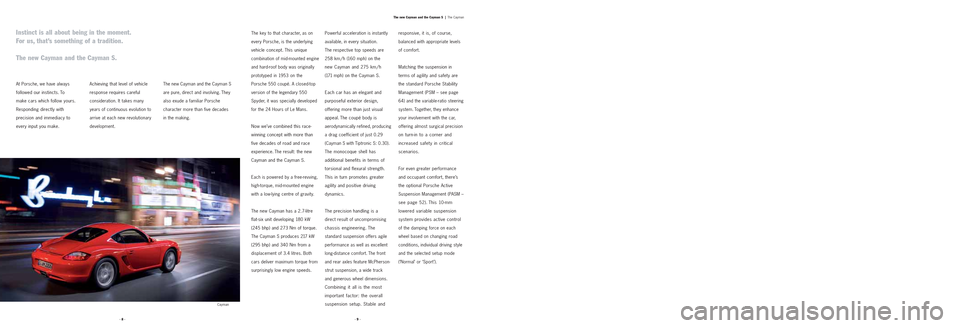
· 9 · · 8 ·
At Porsche, we have always
followed our instincts. To
make cars which follow yours.
Responding directly with
precision and immediacy to
every input you make.
Instinct is all about being in the moment.
For us, that’s something of a tradition.
The new Cayman and the Cayman S.
Achieving that level of vehicle
response requires careful
consideration. It takes many
years of continuous evolution to
arrive at each new revolutionary
development.The new Cayman and the Cayman S
are pure, direct and involving. They
also exude a familiar Porsche
character more than five decades
in the making.
The new Cayman and the Cayman S |The Cayman
The key to that character, as on
every Porsche, is the underlying
vehicle concept. This unique
combination of mid-mounted engine
and hard-roof body was originally
prototyped in 1953 on the
Porsche
550 coupé. A closed-top
version of the legendary 550
Spyder, it was specially developed
for the 24 Hours of Le Mans.
Now we’ve combined this race-
winning concept with more than
five decades of road and race
experience. The result: the new
Cayman and the Cayman S.
Each is powered by a free-revving,
high-torque, mid-mounted engine
with a low-lying centre of gravity.
The new Cayman has a 2.7-litre
flat-six unit developing 180 kW
(245 bhp) and 273 Nm of torque.
The Cayman S produces 217 kW
(295 bhp) and 340 Nm from a
displacement of 3.4 litres. Both
cars deliver maximum torque from
surprisingly low engine speeds.Powerful acceleration is instantly
available, in every situation.
The respective top speeds are
258 km / h (160 mph) on the
new Cayman and 275 km / h
(171 mph) on the Cayman S.
Each car has an elegant and
purposeful exterior design,
offering more than just visual
appeal. The coupé body is
aerodynamically refined, producing
a drag coefficient of just 0.29
(Cayman S with Tiptronic S: 0.30).
The monocoque shell has
additional benefits in terms of
torsional and flexural strength.
This in turn promotes greater
agility and positive driving
dynamics.
The precision handling is a
direct result of uncompromising
chassis engineering. The
standard suspension offers agile
performance as well as excellent
long-distance comfort. The front
and rear axles feature McPherson-
strut suspension, a wide track
and generous wheel dimensions.
Combining it all is the most
important factor: the overall
suspension setup. Stable and
responsive, it is, of course,
balanced with appropriate levels
of comfort.
Matching the suspension in
terms of agility and safety are
the standard Porsche Stability
Management (PSM – see page
64) and the variable-ratio steering
system. Together, they enhance
your involvement with the car,
offering almost surgical precision
on turn-in to a corner and
increased safety in critical
scenarios.
For even greater performance
and occupant comfort, there’s
the optional Porsche Active
Suspension Management (PASM –
see page 52). This 10-mm
lowered variable suspension
system provides active control
of the damping force on each
wheel based on changing road
conditions, individual driving style
and the selected setup mode
(‘Normal’ or ‘Sport’).
Cayman
Page 11 of 61
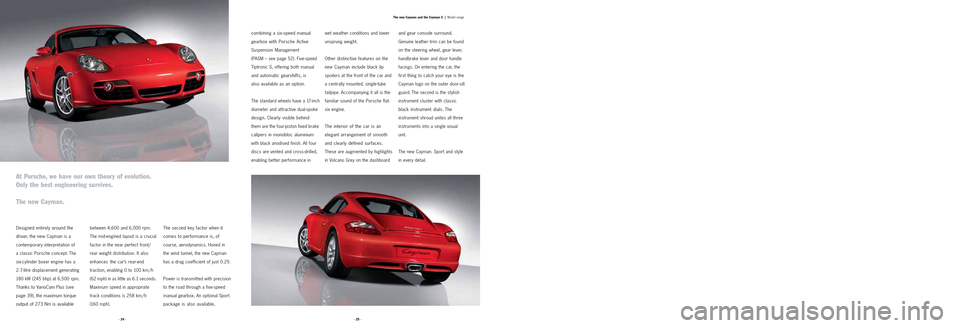
· 25 ·
Designed entirely around the
driver, the new Cayman is a
contemporary interpretation of
a classic Porsche concept. The
six-cylinder boxer engine has a
2.7-litre displacement generating
180 kW (245 bhp) at 6,500 rpm.
Thanks to VarioCam Plus (see
page 39), the maximum torque
output of 273 Nm is available
between 4,600 and 6,000 rpm.
The mid-engined layout is a crucial
factor in the near perfect front/
rear weight distribution. It also
enhances the car’s rear-end
traction, enabling 0 to 100 km / h
(62 mph) in as little as 6.1 seconds.
Maximum speed in appropriate
track conditions is 258 km / h
(160 mph).
The second key factor when it
comes to performance is, of
course, aerodynamics. Honed in
the wind tunnel, the new Cayman
has a drag coefficient of just 0.29.
Power is transmitted with precision
to the road through a five-speed
manual gearbox. An optional Sport
package is also available,
The new Cayman and the Cayman S |Model range
combining a six-speed manual
gearbox with Porsche Active
Suspension Management
(PASM – see page 52). Five-speed
Tiptronic S, offering both manual
and automatic gearshifts, is
also available as an option.
The standard wheels have a 17-inch
diameter and attractive dual-spoke
design. Clearly visible behind
them are the four-piston fixed brake
calipers in monobloc aluminium
with black anodised finish. All four
discs are vented and cross-drilled,
enabling better performance in wet weather conditions and lower
unsprung weight.
Other distinctive features on the
new Cayman include black lip
spoilers at the front of the car and
a centrally mounted, single-tube
tailpipe. Accompanying it all is the
familiar sound of the Porsche flat-
six engine.
The interior of the car is an
elegant arrangement of smooth
and clearly defined surfaces.
These are augmented by highlights
in Volcano Grey on the dashboard
At Porsche, we have our own theory of evolution.
Only the best engineering survives.
The new Cayman.
· 24 ·
and gear console surround.
Genuine leather trim can be found
on the steering wheel, gear lever,
handbrake lever and door handle
facings. On entering the car, the
first thing to catch your eye is the
Cayman logo on the outer door-sill
guard. The second is the stylish
instrument cluster with classic
black instrument dials. The
instrument shroud unites all three
instruments into a single visual
unit.
The new Cayman. Sport and style
in every detail.
Page 12 of 61
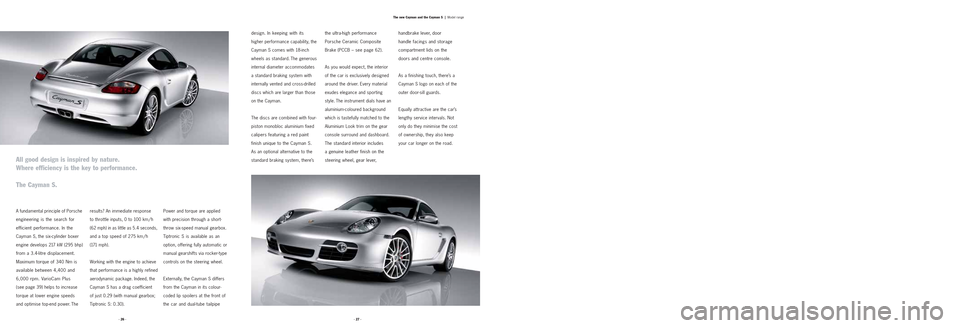
· 27 · · 26 ·
A fundamental principle of Porsche
engineering is the search for
efficient performance. In the
Cayman S, the six-cylinder boxer
engine develops 217 kW (295 bhp)
from a 3.4-litre displacement.
Maximum torque of 340 Nm is
available between 4,400 and
6,000 rpm. VarioCam Plus
(see page 39) helps to increase
torque at lower engine speeds
and optimise top-end power. Theresults? An immediate response
to throttle inputs, 0 to 100 km / h
(62 mph) in as little as 5.4 seconds,
and a top speed of 275 km / h
(171 mph).
Working with the engine to achieve
that performance is a highly refined
aerodynamic package. Indeed, the
Cayman S has a drag coefficient
of just 0.29 (with manual gearbox;
Tiptronic S: 0.30).
Power and torque are applied
with precision through a short-
throw six-speed manual gearbox.
Tiptronic S is available as an
option, offering fully automatic or
manual gearshifts via rocker-type
controls on the steering wheel.
Externally, the Cayman S differs
from the Cayman in its colour-
coded lip spoilers at the front of
the car and dual-tube tailpipe
The new Cayman and the Cayman S |Model range
design. In keeping with its
higher performance capability, the
Cayman S comes with 18-inch
wheels as standard. The generous
internal diameter accommodates
a standard braking system with
internally vented and cross-drilled
discs which are larger than those
on the Cayman.
The discs are combined with four-
piston monobloc aluminium fixed
calipers featuring a red paint
finish unique to the Cayman S.
As an optional alternative to the
standard braking system, there’s
the ultra-high performance
Porsche Ceramic Composite
Brake (PCCB – see page 62).
As you would expect, the interior
of the car is exclusively designed
around the driver. Every material
exudes elegance and sporting
style. The instrument dials have an
aluminium-coloured background
which is tastefully matched to the
Aluminium Look trim on the gear
console surround and dashboard.
The standard interior includes
a genuine leather finish on the
steering wheel, gear lever,
All good design is inspired by nature.
Where efficiency is the key to performance.
The Cayman S.
handbrake lever, door
handle facings and storage
compartment lids on the
doors and centre console.
As a finishing touch, there’s a
Cayman S logo on each of the
outer door-sill guards.
Equally attractive are the car’s
lengthy service intervals. Not
only do they minimise the cost
of ownership, they also keep
your car longer on the road.
Page 14 of 61

· 31 · · 30 ·
At the heart of each car:
something to set the pulse racing.
Powering the Cayman and Cayman S.
Six-cylinder boxer engine.
Both Cayman models have a
mid-mounted six-cylinder boxer
engine featuring VarioCam Plus
technology. Ideally positioned
directly behind the driver, the
‘flat-six’ engine provides an
The new Cayman and the Cayman S |Drive
0 20
40 60 80 100
120 140 160 180
200
220
1500
7500 2000 2500 3000 3500 4000 4500 5000 5500 6000 6500 7000 1000 240
240 280 290
300
310
320 330 340
350
250 260
270
217 kW (295 bhp)
340 Nm
360
Power (kW)Torque (Nm)
Engine speed (rpm)
Cayman S: 340 Nm between 4,400 and 6,000 rpm, 217 kW (295 bhp) at 6,250 rpm
150 230 250
270
290
310 330 350
3700 20
40 60 80 100
120 140 160 180
200
220
1500
7500 2000 2500 3000 3500 4000 4500 5000 5500 6000 6500 7000
170 190
210
1000
180 kW (245 bhp)
273 Nm 240
390
Power (kW)Torque (Nm)
Engine speed (rpm)
Cayman: 273 Nm between 4,600 and 6,000 rpm, 180 kW (245 bhp) at 6,500 rpm
Cayman S: 3.4-litre six-cylinder boxer engine
perfectly augmented by the agility
its position in the car provides.
The new Cayman has a 2.7-litre
engine developing 180 kW
(245 bhp). The 3.4-litre unit in
the Cayman S produces 217 kW
(295 bhp).On both cars, maximum torque
output is available for use over
much of the engine speed range.
The new Cayman has a maximum
rating of 273 Nm between 4,600 and 6,000 rpm. On the
Cayman S, the maximum output
of 340 Nm is available between
4,400 and 6,000 rpm. This
broad band of torque is, in part,a product of the resonance
induction manifold with twin-flow
intake pipe as well as VarioCam
Plus technology (see page 39).
exceptionally low centre of
gravity. Important characteristics
include exhilarating power
delivery, a free-revving throttle,
optimum cylinder charging,
smooth engine running and
superlative all-round performance.
The power of each engine is
Page 15 of 61

· 33 · · 32 ·The new Cayman and the Cayman S |
Drive
The variable valve system
generates additional torque at
lower engine speeds. Other
benefits include greater top-end
power, better fuel economy
and lower exhaust emissions.
Fuel injection and ignition
are centrally controlled by
the Motronic ME7.8 engine
management system. Power
is applied with control and
precision by means of an
electronically operated throttle.
The engine sound, so rich and
distinctive, is also instantly
Porsche.
Cayman
Page 18 of 61

· 39 · · 38 ·VarioCam Plus The new Cayman and the Cayman S |
Drive
higher torque at low rpm, a flatter
torque curve, and greater top-end
power. It also brings an additional
dimension to the unique engine
sound.VarioCam Plus.
VarioCam Plus combines variable
valve timing with two-stage lift
on the inlet side. The resulting
benefits include greater power and
torque at all engine speeds, as
well as smoother running, better
fuel economy and fewer exhaust
emissions.
Essentially, the system creates
two engines out of one, switching
seamlessly between them as
driver inputs change. All operations
are centrally controlled by
the Motronic ME7.8 engine
management system. The result:
rapid acceleration and balanced
running characteristics.
The two-stage valve lift mechanism
on the inlet side incorporates
a series of electro-hydraulically
switchable tappets. Each of
the 12 tappets consists of two
concentric lifters which can be
locked together by means of a
pin when required by the engine
management system. When the
tappets are locked, the outermost
ring – which is driven by two large-
profile cams – is in direct contact
Two-stage resonance intake
manifold.
The intake manifold has a twin-flow
pipe with two-stage valve which
opens and closes at predefined
engine speeds. An additional
‘resonance’ pipe connecting the
twin plenum chambers is used
to alter the geometry within the
manifold. The resulting vibration in
the incoming air helps to maximise
cylinder charging and create the
optimum air/fuel mix. The results:
with the valve. When the pin is
removed, the innermost lifter –
operated by a smaller cam lobe –
has sole influence over the
amount of valve lift. The timing of
each valve is steplessly controlled
by means of an electro-hydraulic
rotary vane adjuster at the head
of each inlet camshaft.
To improve responsiveness when
starting from cold, VarioCam Plus
will raise the amount of lift and
retard the timing of the valves.
At medium revs and minimal load,
the valve lift is lowered and timing
advanced to help minimise fuel
consumption and emissions.
To achieve maximum power and
torque, the lift is raised and the
timing advanced.
Cayman
Page 19 of 61
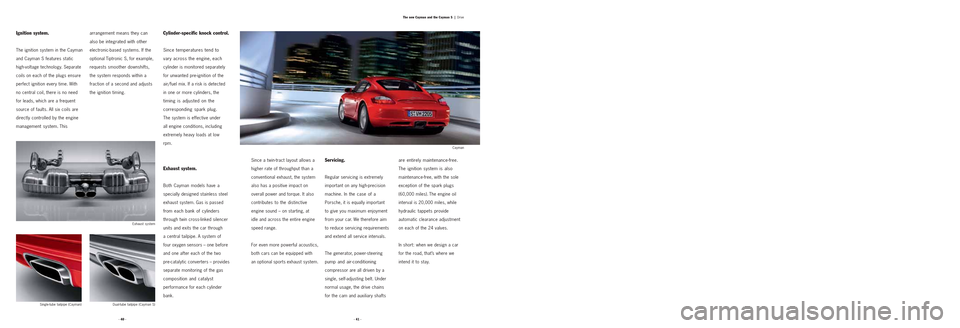
· 41 · · 40 ·The new Cayman and the Cayman S |
Drive
Ignition system.
The ignition system in the Cayman
and Cayman S features static
high-voltage technology. Separate
coils on each of the plugs ensure
perfect ignition every time. With
no central coil, there is no need
for leads, which are a frequent
source of faults. All six coils are
directly controlled by the engine
management system. This
Cylinder-specific knock control.
Since temperatures tend to
vary across the engine, each
cylinder is monitored separately
for unwanted pre-ignition of the
air/fuel mix. If a risk is detected
in one or more cylinders, the
timing is adjusted on the
corresponding spark plug.
The system is effective under
all engine conditions, including
extremely heavy loads at low
rpm.
Exhaust system.
Both Cayman models have a
specially designed stainless steel
exhaust system. Gas is passed
from each bank of cylinders
through twin cross-linked silencer
units and exits the car through
a central tailpipe. A system of
four oxygen sensors – one before
and one after each of the two
pre-catalytic converters – provides
separate monitoring of the gas
composition and catalyst
performance for each cylinder
bank.
arrangement means they can
also be integrated with other
electronic-based systems. If the
optional Tiptronic S, for example,
requests smoother downshifts,
the system responds within a
fraction of a second and adjusts
the ignition timing.
Since a twin-tract layout allows a
higher rate of throughput than a
conventional exhaust, the system
also has a positive impact on
overall power and torque. It also
contributes to the distinctive
engine sound – on starting, at
idle and across the entire engine
speed range.
For even more powerful acoustics,
both cars can be equipped with
an optional sports exhaust system.
Servicing.
Regular servicing is extremely
important on any high-precision
machine. In the case of a
Porsche, it is equally important
to give you maximum enjoyment
from your car. We therefore aim
to reduce servicing requirements
and extend all service intervals.
The generator, power-steering
pump and air-conditioning
compressor are all driven by a
single, self-adjusting belt. Under
normal usage, the drive chains
for the cam and auxiliary shafts
are entirely maintenance-free.
The ignition system is also
maintenance-free, with the sole
exception of the spark plugs
(60,000 miles). The engine oil
interval is 20,000 miles, while
hydraulic tappets provide
automatic clearance adjustment
on each of the 24 valves.
In short: when we design a car
for the road, that’s where we
intend it to stay.Exhaust system
Dual-tube tailpipe (Cayman S) Single-tube tailpipe (Cayman)Cayman
Page 25 of 61

· 53 · · 52 ·The new Cayman and the Cayman S |
Chassis
Porsche Active Suspension
Management (PASM).
PASM is an electronic damping
control system. Available on
both Cayman models, it offers
continuous adjustment of
individual damping forces based
on current road conditions and
driving style. Agility and driving
pleasure are significantly
enhanced while retaining the
car’s natural ride quality. Equipped
with PASM, the car rides 10 mm
lower than with the standard
steel-sprung suspension.
The driver can choose one of
two setup modes, ‘Normal’ or
‘Sport’. While the first is a blend
of performance and comfort, the
‘Sport’ setup ratings are generally
much firmer, enabling greater
agility on the racetrack. In either
mode, the system responds to
changing loads by automatically
applying the optimum damping
rate on each individual wheel.
The rates are selected from a
range of map options which are
specially adapted to the unique
dynamics of the Cayman and
Cayman S.
The movement of the body is
continuously monitored under
acceleration, braking and cornering
manoeuvres, as well as on poor
road surfaces. Other sensors
provide additional information on
lateral acceleration, steering
angle, brake pressure and engine
torque. A dedicated control unitprovides real-time analysis and
damper adjustment as defined
for the respective setup mode
(‘Normal’ or ‘Sport’). The result:
greater stability and more
consistent occupant comfort.
If, when ‘Sport’ mode is selected,
the quality of road surface drops
below a certain threshold, the
system immediately switches
to
a softer rating and restores
the car’s traction and grip.
When the road surface improves,
PASM returns to the original,
harder ratings. The system
remains active in ‘Normal’ mode,
too, automatically switching to a
harder setup if the car is driven
more assertively. As the dampers
become stiffer, the car becomes
more stable and driver control is
improved.
Rebound in ‘Normal’ mode –
damper piston with bypass
valve openRebound in ‘Sport’ mode –
damper piston with bypass
valve closed
Compression in ‘Sport’ mode –
damper piston with bypass
valve closed Compression in ‘Normal’ mode –
damper piston with bypass
valve open
Page 26 of 61
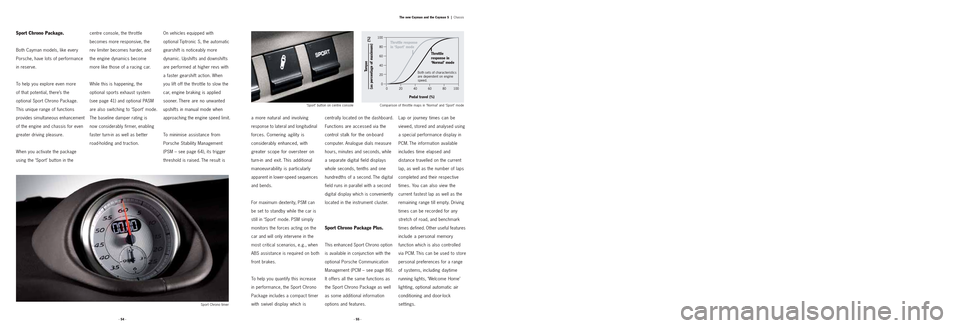
· 54 ·The new Cayman and the Cayman S |
Chassis
a more natural and involving
response to lateral and longitudinal
forces. Cornering agility is
considerably enhanced, with
greater scope for oversteer on
turn-in and exit. This additional
manoeuvrability is particularly
apparent in lower-speed sequences
and bends.
For maximum dexterity, PSM can
be set to standby while the car is
still in ‘Sport’ mode. PSM simply
monitors the forces acting on the
car and will only intervene in the
most critical scenarios, e.g., when
ABS assistance is required on both
front brakes.
To help you quantify this increase
in performance, the Sport Chrono
Package includes a compact timer
with swivel display which is
centrally located on the dashboard.
Functions are accessed via the
control stalk for the on-board
computer. Analogue dials measure
hours, minutes and seconds, while
a separate digital field displays
whole seconds, tenths and one
hundredths of a second. The digital
field runs in parallel with a second
digital display which is conveniently
located in the instrument cluster.
Sport Chrono Package Plus.
This enhanced Sport Chrono option
is available in conjunction with the
optional Porsche Communication
Management (PCM – see page 86).
It offers all the same functions as
the Sport Chrono Package as well
as some additional information
options and features.
‘Sport’ button on centre console
Lap or journey times can be
viewed, stored and analysed using
a special performance display in
PCM. The information available
includes time elapsed and
distance travelled on the current
lap, as well as the number of laps
completed and their respective
times. You can also view the
current fastest lap as well as the
remaining range till empty. Driving
times can be recorded for any
stretch of road, and benchmark
times defined. Other useful features
include a personal memory
function which is also controlled
via PCM. This can be used to store
personal preferences for a range
of systems, including daytime
running lights, ‘Welcome Home’
lighting, optional automatic air
conditioning and door-lock
settings.
· 55 ·
Sport Chrono Package.
Both Cayman models, like every
Porsche, have lots of performance
in reserve.
To help you explore even more
of that potential, there’s the
optional Sport Chrono Package.
This unique range of functions
provides simultaneous enhancement
of the engine and chassis for even
greater driving pleasure.
When you activate the package
using the ‘Sport’ button in the
Throttle response
in ‘Sport’ mode
Throttle
response in
‘Normal’ mode
Both sets of characteristics
are dependent on engine
speed.
Pedal travel (%)
(%) Torque
(as percentage of maximum)
Comparison of throttle maps in ‘Normal’ and ‘Sport’ mode
centre console, the throttle
becomes more responsive, the
rev limiter becomes harder, and
the engine dynamics become
more like those of a racing car.
While this is happening, the
optional sports exhaust system
(see page 41) and optional PASM
are also switching to ‘Sport’ mode.
The baseline damper rating is
now considerably firmer, enabling
faster turn-in as well as better
road-holding and traction.On vehicles equipped with
optional Tiptronic S, the automatic
gearshift is noticeably more
dynamic. Upshifts and downshifts
are performed at higher revs with
a faster gearshift action. When
you lift off the throttle to slow the
car, engine braking is applied
sooner. There are no unwanted
upshifts in manual mode when
approaching the engine speed limit.
To minimise assistance from
Porsche Stability Management
(PSM – see page 64), its trigger
threshold is raised. The result is
Sport Chrono timer
Page 58 of 61
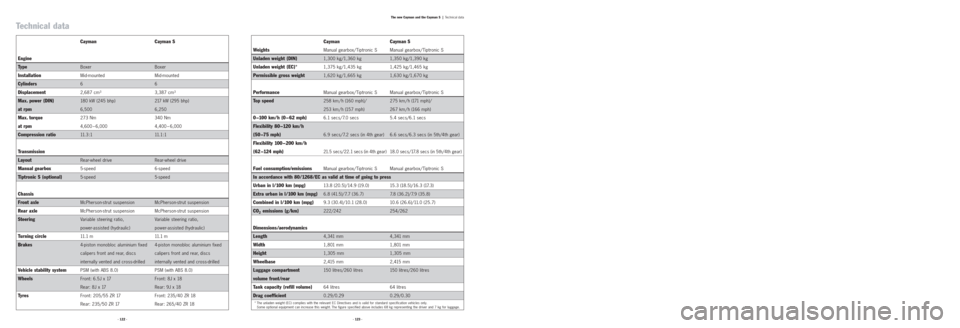
· 122 ·
Technical data
Cayman Cayman S
Engine
TypeBoxer Boxer
InstallationMid-mounted Mid-mounted
Cylinders66
Displacement2,687 cm33,387 cm3
Max. power (DIN) 180 kW (245 bhp) 217 kW (295 bhp)
at rpm6,500 6,250
Max. torque273 Nm 340 Nm
at rpm4,600 – 6,000 4,400 – 6,000
Compression ratio11.3 :1 11.1:1
Transmission
LayoutRear-wheel drive Rear-wheel drive
Manual gearbox 5-speed 6-speed
Tiptronic S (optional)5-speed 5-speed
Chassis
Front axleMcPherson-strut suspension McPherson-strut suspension
Rear axleMcPherson-strut suspension McPherson-strut suspension
SteeringVariable steering ratio, Variable steering ratio,
power-assisted (hydraulic) power-assisted (hydraulic)
Turning circle11. 1 m 11. 1 m
Brakes4-piston monobloc aluminium fixed 4-piston monobloc aluminium fixed
calipers front and rear, discs calipers front and rear, discs
internally vented and cross-drilled internally vented and cross-drilled
Vehicle stability systemPSM (with ABS 8.0) PSM (with ABS 8.0)
Wheels Front: 6.5J x 17 Front: 8J x 18
Rear: 8J x 17 Rear: 9J x 18
Tyres Front: 205/55 ZR 17 Front: 235/40 ZR 18
Rear: 235/50 ZR 17 Rear: 265/40 ZR 18
· 123 ·The new Cayman and the Cayman S |
Technical data
Cayman Cayman S
WeightsManual gearbox/ Tiptronic S Manual gearbox/ Tiptronic S
Unladen weight (DIN)1,300 kg/1,360 kg 1,350 kg/1,390 kg
Unladen weight (EC)* 1,375 kg/1,435 kg 1,425 kg/1,465 kg
Permissible gross weight1,620 kg/1,665 kg 1,630 kg/1,670 kg
Performance Manual gearbox/ Tiptronic S Manual gearbox/ Tiptronic S
Top speed258 km / h (160 mph)/ 275 km / h (171 mph)/
253 km / h (157 mph) 267 km / h (166 mph)
0 –100 km / h (0 – 62 mph) 6.1 secs/7.0 secs 5.4 secs/6.1 secs
Flexibility 80 –120 km / h
(50 –75 mph)6.9 secs/7.2 secs (in 4th gear) 6.6 secs/6.3 secs (in 5th/4th gear)
Flexibility 100 – 200 km / h
(62 –124 mph) 21.5 secs/22.1 secs (in 4th gear)18.0 secs/17.8 secs (in 5th/4th gear)
Fuel consumption/emissionsManual gearbox/ Tiptronic S Manual gearbox/ Tiptronic S
In accordance with 80 / 1268 /EC as valid at time of going to press
Urban in l / 100 km (mpg)13.8 (20.5)/14.9 (19.0) 15.3 (18.5)/16.3 (17.3)
Extra urban in l / 100 km (mpg)6.8 (41.5)/7.7 (36.7) 7.8 (36.2)/7.9 (35.8)
Combined in l / 100 km (mpg)9.3 (30.4)/10.1 (28.0) 10.6 (26.6)/11.0 (25.7)
CO2emissions (g /km)222/242 254/262
Dimensions /aerodynamics
Length4,341 mm 4,341 mm
Width1,801 mm 1,801 mm
Height1,305 mm 1,305 mm
Wheelbase2,415 mm 2,415 mm
Luggage compartment150 litres/260 litres 150 litres/260 litres
volume front /rear
Tank capacity (refill volume)64 litres 64 litres
Drag coefficient0.29/0.29 0.29/0.30
* The unladen weight (EC) complies with the relevant EC Directives and is valid for standard specification vehicles only.
Some optional equipment can increase this weight. The figure specified above includes 68 kg representing the driver and 7 kg for luggage.